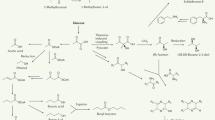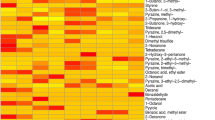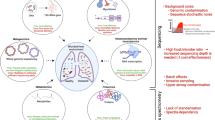Abstract
Microorganisms are important factors in shaping our environment. One key characteristic that has been neglected for a long time is the ability of microorganisms to release chemically diverse volatile compounds. At present, it is clear that the blend of volatiles released by microorganisms can be very complex and often includes many unknown compounds for which the chemical structures remain to be elucidated. The biggest challenge now is to unravel the biological and ecological functions of these microbial volatiles. There is increasing evidence that microbial volatiles can act as infochemicals in interactions among microbes and between microbes and their eukaryotic hosts. Here, we review and discuss recent advances in understanding the natural roles of volatiles in microbe–microbe interactions. Specific emphasis will be given to the antimicrobial activities of microbial volatiles and their effects on bacterial quorum sensing, motility, gene expression and antibiotic resistance.
Similar content being viewed by others
Log in or create a free account to read this content
Gain free access to this article, as well as selected content from this journal and more on nature.com
or
References
Ahmad A, Viljoen AM, Chenia HY . (2014). The impact of plant volatiles on bacterial quorum sensing. Lett Appl Microbiol 60: 8–19.
Atmosukarto I, Castillo U, Hess WH, Sears J, Strobel G . (2005). Isolation and characterization of Muscodor albus I-41.3s, a volatile antibiotic producing fungus. Plant Sci 169: 854–861.
Bernier SP, Letoffe S, Delepierre M, Ghigo J-M . (2011). Biogenic ammonia modifies antibiotic resistance at a distance in physically separated bacteria. Mol Microbiol 81: 705–716.
Bitas V, Kim H-S, Bennett JW, Kang S . (2013). Sniffing on Microbes: diverse roles of microbial volatile organic compounds in plant health. Mol Plant Microbe Interact 26: 835–843.
Blom D, Fabbri C, Eberl L, Weisskopf L . (2011). Volatile-mediated killing of Arabidopsis thaliana by bacteria is mainly due to hydrogen cyanide. Appl Environ Microbiol 77: 1000–1008.
Brana AF, Rodriguez M, Pahari P, Rohr J, Garcia LA, Blanco G . (2014). Activation and silencing of secondary metabolites in Streptomyces albus and Streptomyces lividans after transformation with cosmids containing the thienamycin gene cluster from Streptomyces cattleya. Arch Microbiol 196: 345–355.
Cepl J, Blahuskova A, Cvrckova F, Markos A . (2014). Ammonia produced by bacterial colonies promotes growth of ampicillin-sensitive Serratia sp by means of antibiotic inactivation. FEMS Microbiol Lett 354: 126–132.
Chernin L, Toklikishvili N, Ovadis M, Kim S, Ben-Ari J, Khmel I et al. (2011). Quorum-sensing quenching by rhizobacterial volatiles. Environ Microbiol Rep 3: 698–704.
Claeson AS, Sandstrom M, Sunesson AL . (2007). Volatile organic compounds (VOCs) emitted from materials collected from buildings affected by microorganisms. J Environ Monit 9: 240–245.
Dandurishvili N, Toklikishvili N, Ovadis M, Eliashvili P, Giorgobiani N, Keshelava R et al. (2011). Broad-range antagonistic rhizobacteria Pseudomonas fluorescens and Serratia plymuthica suppress Agrobacterium crown gall tumours on tomato plants. J Appl Microbiol 110: 341–352.
Effmert U, Kalderas J, Warnke R, Piechulla B . (2012). Volatile mediated interactions between bacteria and fungi in the soil. J Chem Ecol 38: 665–703.
Farag MA, Zhang H, Ryu C-M . (2013). Dynamic chemical communication between plants and bacteria through airborne signals: induced resistance by bacterial volatiles. J Chem Ecol 39: 1007–1018.
Gallucci MN, Oliva M, Casero C, Dambolena J, Luna A, Zygadlo J et al. (2009). Antimicrobial combined action of terpenes against the food-borne microorganisms Escherichia coli, Staphylococcus aureus and Bacillus cereus. Flavour Fragr J 24: 348–354.
Garbeva P, Hol WHG, Termorshuizen AJ, Kowalchuk GA, de Boer W . (2011). Fungistasis and general soil biostasis - a new synthesis. Soil Biol Biochem 43: 469–477.
Garbeva P, Hordijk C, Gerards S, De Boer W . (2014a). Volatile-mediated interactions between phylogenetically different soil bacteria. Front Microbiol 5: 285–290.
Garbeva P, Hordijk C, Gerards S, de Boer W . (2014b). Volatiles produced by the mycophagous soil bacterium Collimonas. FEMS Microbiol Ecol 87: 639–649.
Groenhagen U, Baumgartner R, Bailly A, Gardiner A, Eberl L, Schulz S et al. (2013). Production of bioactive volatiles by different Burkholderia ambifaria strains. J Chem Ecol 39: 892–906.
Gurtler H, Pedersen R, Anthoni U, Christophersen C, Nielsen PH, Wellington EMH et al. (1994). Albaflavenone, a sesquiterpene ketone with a zizaene skeleton produced by a streptomycete with a new rope morphology. J Antibiot 47: 434–439.
Hagai E, Dvora R, Havkin-Blank T, Zelinger E, Porat Z, Schulz S et al. (2014). Surface-motility induction, attraction and hitchhiking between bacterial species promote dispersal on solid surfaces. ISME J 8: 1147–1151.
Hemaiswarya S, Doble M . (2010). Synergistic interaction of phenylpropanoids with antibiotics against bacteria. J Med Microbiol 59: 1469–1476.
Herrington PR, Craig JT, Chea CY, Sheridan JE . (1985). Inhibition of spore germination by volatiles from Streptomyces griseoruber. Soil Biol Biochem 17: 897–898.
Herrington PR, Craig JT, Sheridan JE . (1987). Methyl vinyl ketone - a volatile fungistatic inhibitor from Streptomyces griseoruber. Soil Biol Biochem 19: 509–512.
Hornby JM, Jensen EC, Lisec AD, Tasto JJ, Jahnke B, Shoemaker R et al. (2001). Quorum sensing in the dimorphic fungus Candida albicans is mediated by farnesol. Appl Environ Microbiol 67: 2982–2992.
Hunziker L, Boenisch D, Groenhagen U, Bailly A, Schulz S, Weisskopf L . (2015). Pseudomonas strains naturally associated with potato plants produce volatiles with high potential for inhibition of Phytophthora infestans. Appl Environ Microbiol 81: 821–830.
Insam H, Seewald MSA . (2010). Volatile organic compounds (VOCs) in soils. Biol Fertil soils 46: 199–213.
Junker RR, Tholl D . (2013). Volatile organic compound mediated interactions at the plant-microbe interface. J Chem Ecol 39: 810–825.
Kai M, Effmert U, Berg G, Piechulla B . (2007). Volatiles of bacterial antagonists inhibit mycelial growth of the plant pathogen Rhizoctonia solani. Arch Microbiol 187: 351–360.
Kai M, Haustein M, Molina F, Petri A, Scholz B, Piechulla B . (2009). Bacterial volatiles and their action potential. Appl Microbiol Biotechnol 81: 1001–1012.
Kim K-S Lee S, Ryu C-M Interspecific bacterial sensing through airborne signals modulates locomotion and drug resistance. Nat Commun,. (2013) 4: 1809.
Korpi A, Jarnberg J, Pasanen AL . (2009). Microbial volatile organic compounds. Crit Rev Toxicol 39: 139–193.
Lee HH, Molla MN, Cantor CR, Collins JJ . (2010). Bacterial charity work leads to population-wide resistance. Nature 467: 82–U113.
Lemfack MC, Nickel J, Dunkel M, Preissner R, Piechulla B . (2014). mVOC: a database of microbial volatiles. Nucleic Acids Res 42: D744–D748.
Létoffé S, Audrain B, Bernier SP, Delepierre M, Ghigo J-M . (2014). Aerial exposure to the bacterial volatile compound trimethylamine modifies antibiotic resistance of physically separated bacteria by raising culture medium pH. MBio 5: e00944–13.
Lupetti A, Danesi R, Campa M, Del Tacca M, Kelly S . (2002). Molecular basis of resistance to azole antifungals. Trends Mol Med 8: 76–81.
Lushchak VI . (2001). Oxidative stress and mechanisms of protection against it in bacteria. Biochemistry (Mosc) 66: 476–489.
Marquez-Villavicencio MdP, Weber B, Witherell RA, Willis DK, Charkowski AO . (2011). The 3-hydroxy-2-butanone pathway is required for pectobacterium carotovorum pathogenesis. PLoS One 6: e22974.
Martins M, Henriques M, Azeredo J, Rocha SM, Coimbra MA, Oliveira R . (2007). Morphogenesis control in Candida albicans and Candida dubliniensis through signaling molecules produced by planktonic and biofilm cells. Eukaryot Cell 6: 2429–2436.
Minerdi D, Moretti M, Gilardi G, Barberio C, Gullino ML, Garibaldi A . (2008). Bacterial ectosymbionts and virulence silencing in a Fusarium oxysporum strain. Environ Microbiol 10: 1725–1741.
Minerdi D, Bossi S, Gullino ML, Garibaldi A . (2009). Volatile organic compounds: a potential direct long-distance mechanism for antagonistic action of Fusarium oxysporum strain MSA 35. Environ Microbiol 11: 844–854.
Mitchell AM, Strobel GA, Moore E, Robison R, Sears J . (2010). Volatile antimicrobials from Muscodor crispans, a novel endophytic fungus. Microbiology 156: 270–277.
Molina-Santiago C, Daddaoua A, Fillet S, Duque E, Ramos J-L . (2014). Interspecies signalling: Pseudomonas putida\ efflux pump TtgGHI is activated by indole to increase antibiotic resistance. Environm Microbiol 16: 1267–1281.
Moody SC, Zhao B, Lei L, Nelson DR, Mullins JG, Waterman MR et al. (2012). Investigating conservation of the albaflavenone biosynthetic pathway and CYP170 bifunctionality in streptomycetes. FEBS J 279: 1640–1649.
Nemcovic M, Jakubikova L, Viden I, Farkas V . (2008). Induction of conidiation by endogenous volatile compounds in Trichoderma spp. FEMS Microbiol Lett 284: 231–236.
Peñuelas J, Asensio D, Tholl D, Wenke K, Rosenkranz M, Piechulla B et al. (2014). Biogenic volatile emissions from the soil. Plant Cell Environ 37: 1866–1891.
Pessi G, Haas D . (2000). Transcriptional control of the hydrogen cyanide biosynthetic genes hcnABC by the anaerobic regulator ANR and the quorum-sensing regulators LasR and RhlR in Pseudomonas aeruginosa. J Bacteriol 182: 6940–6949.
Piechulla B, Degenhardt J . (2014). The emerging importance of microbial volatile organic compounds. Plant Cell Environ 37: 811–812.
Rajini KS, Aparna P, Sasikala C, Ramana CV . (2011). Microbial metabolism of pyrazines. Crit Rev Microbiol 37: 99–112.
Romoli R, Papaleo MC, De Pascale D, Tutino ML, Michaud L, LoGiudice et al. (2014). GC-MS volatolomic approach to study the antimicrobial activity of the antarctic bacterium Pseudoalteromonas sp TB41. Metabolomics 10: 42–51.
Schulz S, Dickschat JS . (2007). Bacterial volatiles: the smell of small organisms. Nat Prod Rep 24: 814–842.
Schulz S, Dickschat JS, Kunze B, Wagner-Dobler I, Diestel R, Sasse F . (2010). Biological activity of volatiles from marine and terrestrial bacteria. Mar Drugs 8: 2976–2987.
Seyedmousavi S, Mouton JW, Melchers WJG, Bruggemann RJM, Verweij PE . (2014). The role of azoles in the management of azole-resistant aspergillosis: from the bench to the bedside. Drug Resist Updat 17: 37–50.
Shatalin K, Shatalina E, Mironov A, Nudler E . (2011). H2S: a universal defense against antibiotics in bacteria. Science 334: 986–990.
Snelders E, RAGHIt Veld, AJMM Rijs, Kema GHJ, Melchers WJG, Verweij PE . (2009). Possible environmental origin of resistance of Aspergillus fumigatus to medical triazoles. Appl Environ Microbiol 75: 4053–4057.
Strobel GA, Dirkse E, Sears J, Markworth C . (2001). Volatile antimicrobials from Muscodor albus, a novel endophytic fungus. Microbiology 147: 2943–2950.
Takamatsu S, Lin X, Nara A, Komatsu M, Cane DE, Ikeda H . (2011). Characterization of a silent sesquiterpenoid biosynthetic pathway in Streptomyces avermitilis controlling epi-isozizaene albaflavenone biosynthesis and isolation of a new oxidized epi-isozizaene metabolite. Microb Biotechnol 4: 184–191.
Trombetta D, Castelli F, Sarpietro MG, Venuti V, Cristani M, Daniele C et al. (2005). Mechanisms of antibacterial action of three monoterpenes. Antimicrob Agents Chemother 49: 2474–2478.
Venkataraman A, Rosenbaum MA, Werner JJ, Winans SC, Angenent LT . (2014). Metabolite transfer with the fermentation product 2,3-butanediol enhances virulence by Pseudomonas aeruginosa. ISME J 8: 1210–1220.
Vespermann A, Kai M, Piechulla B . (2007). Rhizobacterial volatiles affect the growth of fungi and Arabidopsis thaliana. Appl Environ Microbiol 73: 5639–5641.
Weise T, Kai M, Gummesson A, Troeger A, von Reuss S, Piepenborn S et al. (2012). Volatile organic compounds produced by the phytopathogenic bacterium Xanthomonas campestris pv. vesicatoria 85-10. Beilstein J Org Chem 8: 579–596.
Wheatley RE . (2002). The consequences of volatile organic compound mediated bacterial and fungal interactions. Antonie Van Leeuwenhoek 81: 357–364.
Young IM, Crawford JW, Nunan N, Otten W, Spiers A . (2008). Microbial distribution in soils: physics and scaling. In: Sparks DL (ed), Advances in Agronomy vol 100. pp 81–121.
Acknowledgements
This work is supported by The Netherlands Organization for Scientific Research (NWO) VIDI personal grant to PG (864.11.015). This is publication 5808 of the Netherlands Institute of Ecology (NIOO-KNAW). We wish to thank the anonymous reviewers for their helpful comments.
Author information
Authors and Affiliations
Corresponding author
Ethics declarations
Competing interests
The authors declare no conflict of interest.
Rights and permissions
About this article
Cite this article
Schmidt, R., Cordovez, V., de Boer, W. et al. Volatile affairs in microbial interactions. ISME J 9, 2329–2335 (2015). https://doi.org/10.1038/ismej.2015.42
Received:
Revised:
Accepted:
Published:
Issue date:
DOI: https://doi.org/10.1038/ismej.2015.42
This article is cited by
-
Fungal Cultivars of Higher Attine Ants Promote Escovopsis Chemotropism
Current Microbiology (2024)
-
Microbial Volatile Compounds: Prospects for Fungal Phytopathogens Management, Mechanisms and Challenges
Journal of Crop Health (2024)
-
Microbial volatiles mediate bacterial evolutionary dynamics
The ISME Journal (2023)
-
Biological activity of volatiles produced by the strains of two Pseudomonas and two Serratia species
Folia Microbiologica (2023)
-
Evaluation of the biocontrol potential of PGPB strains isolated from drought-tolerant tomatoes against fungal pathogens
Journal of Plant Pathology (2023)



